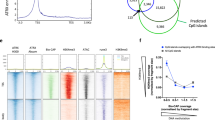Abstract
An erythroid-specific nuclear matrix protein (termed ε-NMPk) in K562 cells, which can specifically bind to the positive stage-specific regulatory element (ε-PRE II, - 446 - 419 bp) upstream of the human ε-globin gene, has been identified by using gel mobility shift assay. Meanwhile, Southwestern blotting assay showed that the nuclear matrix protein ε-NMPk in K562, cells may be composed of two polypeptides (∼ 40 ku). In addition, it is observed in the gel mobility shift assay that the nuclear matrix proteins from K562, HEL and Raji cells can bind to the silencer DNA (- 392 - 177 bp) in the 5′-flanking sequence of human ε-globin gene respectively. However, the shift band K detected in K562 cells is different from shift band H/R in HEL and Raji cells, suggesting that a common nuclear matrix protein may exist in HEL and Raji cells. Results show that the nuclear matrix protein may play an important role in the regulation of the human ε-globin gene expression.
Similar content being viewed by others
References
Getzenherg, R. H., Nuclear matrix and the regulation of gene expression: Tissue specificity,J. Cell Biocherm., 1994, 55: 22.
Tmpicchio, W. L., Dyer, M. A., Baron, M. H., Developmental regiori of the human embryonic β-like globin gene is mediated by synergistic interactions among multiple tissue and stage-spccific elements,Mol. Cell Biol., 1993, 13: 7457.
Cao, S. H., Gutuman, P. D., Dave, H. P. G.et al., Identification of a transcriptional silencer in the 5′-flanking region of the human ε-globin gene, inProc. Natl. Acad. Sci. USA, 1989, 86: 5306.
Fey, F., G., Penman, P. S., Nuclear matrix proteins reflect ccll typc of origin in cultured human cells.Proc. Natl. Acad. Sci. USA, 1988, 85: 121.
Strauss, F., Varshavsky, A., A protein binds to a satellite DNA repeat at three specific sites that would be brought into mutural proximity by DSA folding in the nucleosome,Cell, 1984, 37: 889.
Erwei, G., Joseph, L. A.et al., Identification of enhancers in the 5′-flanking region of the rabbit surfactarnt protein A(SP-A) gene and characterization of their hinding proteins,J. Biol. Chem., 1993. 268: 19697.
Wada, Y., Noguchi, C. T.,In vitro differential expression of human globin gene,J. Biol. Chem., 1988, 263: 12142.
Martin, P., Papyannopoulou, T., A new human erythroleukcmin cell line with spontaneous and induced globin expression,Science, 1982, 216: 12233.
Author information
Authors and Affiliations
About this article
Cite this article
Yan, Z., Qian, R. Interactions between the nuclear matrix proteins and the 5′-flankingcis-acting elements of the human ε-globin gene. Chin. Sci. Bull. 44, 808–811 (1999). https://doi.org/10.1007/BF02885025
Received:
Issue Date:
DOI: https://doi.org/10.1007/BF02885025




